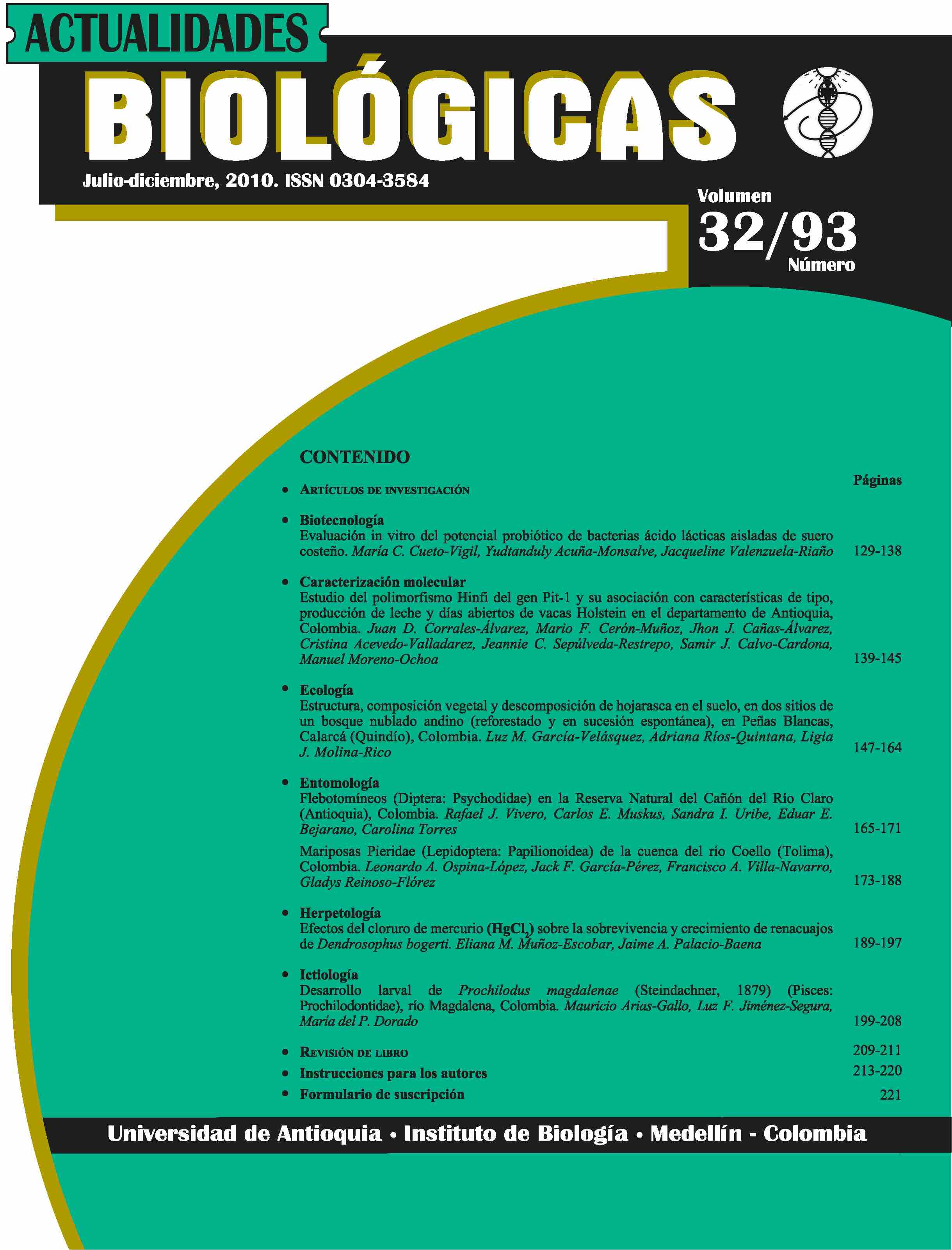Phlebotominae sand flies (Diptera: Psychodidae) in the Nature Reserve Area of Río Claro (Antioquia), Colombia
DOI:
https://doi.org/10.17533/udea.acbi.13812Keywords:
Colombia, Diptera, leishmaniasis, Psychodidae, vectorsAbstract
Considering the endemicity of leishmaniasis in the Antioquia region, Colombia, it is important to have an updated distribution of different phlebotomine sand fly species, as their distribution is a relevant factor for establishing the role of such species in the disease epidemiology. This study evaluated the current composition of phlebotomine sand flies of the genera Lutzomyia and Brumptomyia in the natural reserve of the Río Claro Canyon (Antioquia), following entomological surveys in May, June, and August of 2008. Insects were collected using light traps such as CDC and Shannon, and through active searches using mouth aspirators as collecting devices on substrates such as tree holes and buttresses. We provide the first record of Lutzomyia ayrozai, L. camposi, L. carrerai thula, L. dasymera, L. isovespertilionis, L. micropyga, L. olmeca bicolor, L. cayennensis cayennensis, L. pilosa, and L. shannoni in the reserve of Río Claro. We also report the first finding of Brumptomyia hamata and B. mesai in the Antioquia region, highlighting the occurrence of L. gomezi, L. hartmanni, L. panamensis, L. trapidoi, and L. yuilli because these species are known as potential vectors of cutaneous leishmaniasis in Colombia. Documenting the presence of L. longipalpis (Lutz and Neiva) ten years after its previous record in the area is noteworthy, given that this species is the vector of Leishmania infantum, the aetiological agent of visceral leishmaniasis.
Downloads
References
Alvar JP. 2001. La leishmaniasis: de la biología al control. Centro colaborador de la OMS para leishmaniasis. Servicio de Parasitología. Centro Nacional de Microbiología. Instituto de Salud Carlos III. Madrid. 2: 1-199.
Bejarano E. 2006. Lista actualizada de los psicódidos (Diptera: Psychodidae) de Colombia. Folia Entomológica Mexicana, 45: 47-56.
Bejarano EE, Castro M, Pérez DA, Hernández OE, Vélez A, Vélez ID. 2007. Primer informe de Lutzomyia França en el departamento de Guainía, Amazonia Colombiana, y de Brumptomyia mesai Sherlock
(Diptera: Psychodidae) en el litoral Caribe colombiano. Neotropical Entomology, 36 (6): 990-993.
Christensen HA, Herrer A, Telford SR. 1972. Enzootic cutaneous leishmaniasis in eastern Panama. II. Entomological investigations. Annals of Tropical Medicine and Parasitology, 66: 55-66.
Cochero S, Anaya Y, Días Y, Paternina M, Luna A, Paternina L, Bejarano E. 2007. Infección natural de Lutzomyia cayennensis cayennensis con parásitos tripanosomastídeos (Kinetoplastida: Trypanosomatide) en los Montes de María, Colombia. Revista Cubana de Medicina Tropical, 61 (3): 59-66.
DSSA (Dirección Seccional de Salud y Protección Social de Antioquia). 2010. Eventos de interés en salud pública por municipio 2007-2009. Enfermedades trasmitidas por vectores. Fecha de acceso: 19 de agosto de 2010. Disponible en: <http://www.dssa.gov.co/index.php/
estadisticas/eventos-de-salud-publica>.
Fraiha H, Shaw JJ, Lainson R. 1970. Phlebotominae brasileiros – I: Descrição de uma nova espécie de Brumptomyia, e chave para identificação dos machos das espécies do gênero (Diptera, Psychodidae). Revista Brasileira de Biologia, 30: 465-470.
Galati EA. 2003. Morfologia, terminologia de adultos e identificação dos táxons da América. En: Rangel EF, Lainson R, editores. Flebotomíneos do Brasil. Río do Janeiro (Brasil): Editora Fiocruz. p. 53-175.
Holdridge LR. 1967. Ecología basada en zonas de vida. San José (Costa Rica): Tropical Science Center. p. 206. Ibáñez-Bernal BS. 1999. Phlebotominae de México. I. Brumptomyia França y Parrot; Lutzomyia França, las especies de L. (Lutzomyia) França y del grupo verrucarum. Folia Entomologica Mexicana, 107: 61-116.
Kamhawi S. 2006. Phlebotominae sand flies and Leishmania parasites: friends or foes? Trends in Parasitology, 22 (9): 439-445.
Kreutzer RD, Corredor A, Grimaldi G, Grogl M, Rowton ED, Young DG, Morales A, Mcmahon PD, Guzmán H, Tesh RB. 1991. Characterization of Leishmania colombiensis sp. n. (Kinetoplastida: Trypanosomatidae), a new parasite infecting humans, animals, and phlebotomine sand flies in Colombia and Panama. American Journal
of Tropical Medicine and Hygiene, 44: 662-675.
Lewis D, Young D, Fairchild G, Minter D. 1977. Proposals for a stable classification of the phlebotomine sand flies (Diptera: Psychodidae). Systematic Entomology, 2: 319-332.
López Y, Osorio L, Álvarez G, Rojas J, Jiménez F, Ferro C. 1996. Sandfly Lutzomyia longipalpis in a cutaneous leishmaniasis focus in Central Colombia. Memorias do Instituto Oswaldo Cruz, 91 (4): 415-419.
OMS (Organización Mundial de la Salud). 2009. Control de la leishmaniasis. Consejo Ejecutivo. Informe de la Secretaría. 126.a reunión. EB126/16. Fecha de acceso: 17 de diciembre de 2010. Disponible en: <http://apps.who.int/gb/ebwha/pdf_files/EB126/B126_16-sp.pdf >.
Perruolo G. 2004. Aspectos ecológicos de Lutzomyia spp. (Diptera: Psychodidae) en un foco endémico de leishmaniasis cutánea en el estado Táchira, Venezuela. Boletín de Malariología y Salud Ambiental, 44 (1): 35-44.
Travi BL, Cerro H, Cadena H, Montoya LJ. 2002. Canine visceral leishmaniasis: dog infectivity to sand flies from nonendemic areas. Research in Veterinary Science, 72: 83-86.
Wolff M. 1994. Flebotomíneos en el departamento de Antioquia. Informe de la presencia de nuevas especies para la región. Entomólogo, 22 (77): 2-6.
Young DG, Duncan MA. 1994. Guide to the identification and geographic distribution of Lutzomyia sand flies in Mexico, the West Indies, Central and South America (Diptera: Psychodidae). Memoirs of the American Entomological Institute, 54: 1-881.
Young DG, Morales A, Kreutzer RD, Alexander JB, Corredor A, Tesh RB, Ferro CC, Rodríguez C. 1987. Isolations of Leishmania braziliensis (Kinetoplastida: Trypanosomatidae) from cryopreserved Colombian
sand flies (Diptera: Psychodidae). Journal of Medical Entomology, 24: 587-589.
Young DG, Perkins PV. 1984. Phlebotomine sand flies of North America (Diptera: Psychodidae). Mosquito News, 44: 263-304.
Downloads
Published
How to Cite
Issue
Section
License
The authors exclusively authorize the Actualidades Biológicas journal to edit and publish the submitted manuscript if its publication is recommended and accepted, without this representing any cost to the Journal or the University of Antioquia.
All the ideas and opinions contained in the articles are sole responsibility of the authors. The total content of the issues or supplements of the journal is protected under the Creative Commons Attribution-NonCommercial-ShareAlike 4.0 International License, so they cannot be used for commercial purposes, but for educational purposes. However, please mention the Actualidades Biológicas journal as a source and send a copy of the publication in which the content was reproduced.












